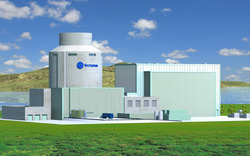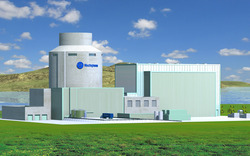 Westinghouse’s AP1000 reactor design. Federal regulators have expressed serious safety concerns about the design for 14 of the nation’s 25 proposed new nuclear reactors, raising questions about the future of what the industry calls its “renaissance.”
Westinghouse’s AP1000 reactor design. Federal regulators have expressed serious safety concerns about the design for 14 of the nation’s 25 proposed new nuclear reactors, raising questions about the future of what the industry calls its “renaissance.”
The Nuclear Regulatory Commission announced last month that Westinghouse failed to demonstrate that the building designed to shield its AP1000 reactor from outside threats such as tornadoes, hurricanes, and earthquakes. In addition, there are concerns about whether the shield building, which also provides a radiation barrier, will be able to support the 8 million-pound emergency cooling water tank that’s supposed to sit on top.
“We’ve been talking to Westinghouse regularly about the shield building since October 2008, and we’ve consistently laid out our questions to the company,” said Michael Johnson, director of the NRC’s Office of New Reactors. “This is a situation where fundamental engineering standards will have to be met before we can begin determining whether the shield building meets the agency’s requirements.”
Pennsylvania-based Westinghouse, which is owned by the Toshiba Group of Japan, downplayed the NRC’s concerns, releasing a statement that said it “fully expected that the NRC would require additional analysis, testing, or actual design modifications to the shield building” and that it had “already begun to address certain portions of the design.” The company says it remains “confident” it will answer the NRC’s concerns.
Whether it does has important implications for the South’s energy future, as all of the planned AP1000 reactors are slated for the region. Two AP1000 units have been proposed at each of the following facilities:
- Tennessee Valley Authority’s Bellefonte plant in Hollywood, Ala.;
- Plant Vogtle near Augusta, Ga., owned by Southern Co. subsidiary Georgia Power.;
- Progress Energy’s Levy County Nuclear Plant in Florida. and its Harris plant in Wake County, N.C.;
- Florida Power & Light’s Turkey Point plant in Miami-Dade County;
- South Carolina Electric & Gas Co.’s V.C. Summer plant northwest of Columbia, S.C.; and
- Duke Energy’s Lee nuclear plant in Cherokee County, S.C.
But nuclear power watchdogs say the reactor’s design problems should mean no taxpayer money in the form of Department of Energy loan guarantees should go toward its construction. Last month, an alliance of 10 nuclear watchdog groups including the Southern Alliance for Clean Energy and the NC Waste Awareness and Reduction Network sent a letter [PDF] to DOE officials calling on the agency to stop issuing conditional loan guarantees to utilities using AP1000 technology. Among the new nuclear projects with AP1000 reactors that the DOE is reportedly considering for loan guarantees are the Vogtle site in Georgia and the Summer site in South Carolina.
“With billions of taxpayer dollars at stake in the proposed nuclear loan guarantees, the Department of Energy owes it to the public to get on the same page as the NRC about these serious AP1000 reactor design problems,” said Sara Barczak, a nuclear power specialist with SACE. “We believe that the DOE should assure the public that utilities considering problematic nuclear reactor designs, such as the AP1000, would not qualify for these loan guarantees.”
A report released earlier this year by the Union of Concerned Scientists found that the potential risk exposure to the federal government and taxpayers from guaranteeing loans to build new nuclear plants — now estimated to cost upwards of $6 billion each — could range from $360 billion to $1.6 trillion. At the same time, a study put out earlier this year by the Vermont Law School’s Institute for Energy and the Environment estimated the per-kilowatt cost of new nuclear plants at two to more than three times the cost of efficiency and renewables.
But the nuclear power industry is pushing hard for more taxpayer assistance — or what some of its critics are calling a “bailout.” Last month, the Nuclear Energy Institute, industry’s lobby group, announced that it wanted to build 45 new reactors by 2030 and was seeking $100 billion in additional loan guarantees.
And the industry has key champions in Washington, as several moderate Republicans including Sen. Lindsay Graham of South Carolina have said policies promoting nuclear power would be necessary for them to vote in favor of climate legislation now being considered in Congress.
Did the AP1000 get improper insider help at the NRC?
A major defense contractor and an important player in the post-Katrina reconstruction of the U.S. Gulf Coast, the Louisiana-based Shaw Group is also the largest provider of commercial nuclear power plant maintenance and modification services in the United States.
The company has long been known for working its insider connections. For example, it was one of several firms that won contracts to rebuild the Gulf Coast after Hurricane Katrina with the help of hired lobbyist Joe Allbaugh — a campaign manager for former President George W. Bush and that administration’s first FEMA director.
But now the Shaw Group faces questions about whether improper insider connections at the NRC benefited its commercial nuclear power ambitions.
Back in 2007, the Project on Government Oversight reported that Nuclear Regulatory Commissioner Jeffrey S. Merrifield “vigorously championed several major policy initiatives that directly benefited his future employer”: the Shaw Group, who he went to work for 12 days after leaving the NRC.
The initiatives Merrifield promoted included a procedural change for certain types of construction activities at nuclear plants that effectively eased environmental restrictions. “Because Shaw is among the largest construction companies in the nuclear industry, few companies stood to benefit more from this initiative,” POGO said at the time.
Then last month, the NRC Inspector General issued a report that confirmed Merrifield twice cast votes during his time on the NRC regarding matters involving companies he had contacted about jobs. The others were Westinghouse and General Electric. The report said the firms could potentially have benefited financially from his votes at the same time Merrifield was negotiating with them for jobs.
In one of the questionable votes, Merrifield voted to change the criteria for emergency cooling systems, a change that would directly benefit Westinghouse, of which the Shaw Group owned a 20 percent interest. He also approved a plan by the Shaw Group to cooperate with China on building nuclear plants using AP1000 technology. China reportedly wants to have 100 AP1000 units operating by 2020.
Merrifield has denied that his job search affected any decision he made while at the NRC. The IG has referred the case to the Department of Justice.
This story originally appeared at Facing South.




